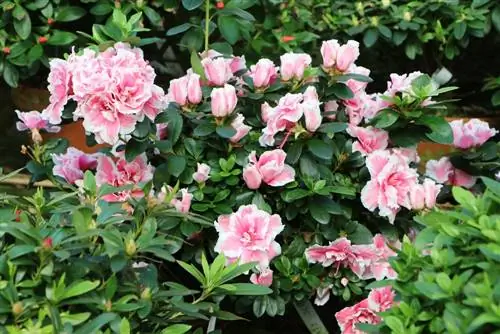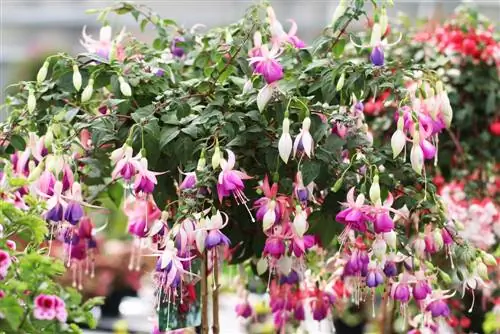- Author admin [email protected].
- Public 2023-12-17 03:39.
- Last modified 2025-06-01 06:48.
An azalea in a pot fulfills flower dreams on the windowsill or balcony. At the end of the flowering period, the question of winter hardiness arises so that the picturesque spectacle is repeated next year. In order to give an informed answer, it is necessary to know whether it is an indoor azalea or a garden azalea. This knowledge leads to the right measures for a he althy winter. This guide explains the differences in the colorful azalea kingdom and provides precise instructions for successful wintering.
Azalea species defines winter hardiness
A short excursion into the botanical background of azaleas provides more information about their winter hardiness. Azaleas are classified in the broad genus Rhododendron, which includes more than 1,000 species. In contrast to the majestic, evergreen flowering shrubs that we are familiar with from parks and gardens, the approximately 100 species of azaleas are comparatively small ornamental trees that are primarily cultivated in pots. The respective origin, growth behavior and flowering time define the specific winter hardiness. We have compiled the outstanding differences for you in a compact form below:
Garden Azalea
- Deciduous flowering shrubs of European or East Asian origin
- Flowering period from May to June, rarely until July
- Hardy to -25 degrees Celsius
As a rule of thumb, every deciduous rhododendron species is classified as a winter-hardy garden azalea. The height of growth extends over a wide range from a delicate 25 to 35 cm for a deciduous Japanese azalea (Rhododendron obtusum) to a majestic 200 cm for the azalea species Rhododendron luteum.
Indoor Azalea
- Evergreen flowering shrubs of tropical or subtropical origin
- Flowering period from September to April
- Not hardy
The species diversity among the non-hardy indoor azaleas is essentially limited to the Indian azalea (Rhododendron simsii) and the evergreen Japanese azalea (Rhododendron japonicum). These two species have resulted in a colorful array of beautiful hybrids that look great on the windowsill. Their growth height ranges from 30 to 60 cm, the ideal format for a houseplant.
Overwintering garden azaleas in pots - this is how it works
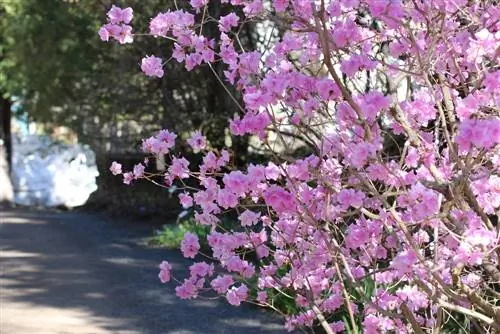
Have you identified your azalea as a hardy garden species with a summer flowering period? Then there is no need for special winter protection for planted specimens. In pot culture, however, the root system is in an exposed position, which offers an open flank to bitter frost. Vessel walls and substrate are far from fulfilling the protective function of a garden floor. To ensure that the flower beauties survive the cold season unscathed, the focus is on the following measures, which depend on the pot size:
Pot diameter larger than 30 cm:
- Do not fertilize from July onwards
- Before the first frost, spend in front of a house wall protected from wind and rain
- Place the pot on a wooden block or a thick Styrofoam mat
- Wrap several layers of foil or fleece around the vessel
- Cover the substrate with leaves or bark mulch
Pot diameter smaller than 30 cm:
- Do not fertilize from July onwards
- Put away after the first frosty night at the latest
- The winter quarters are frost-free and not too warm
- Ideal temperatures are between 3 and 10 degrees Celsius
Regardless of whether your potted azalea overwinters indoors or outdoors, it must not come under drought stress. Therefore, water with soft, lime-free water when the substrate surface is dry. Snow water is ideal for watering outdoors, as it has the ideal temperature to supply the cooled root ball with moisture.
Since garden azaleas shed their leaves, the location can be shady or dark. Hardy potted azaleas are not suitable for overwintering in a bright, well-heated living room. The flower induction for the next season is absolutely dependent on winter growth dormancy under cool conditions.
Tip:
Flowering azalea hybrids are usually grafted onto a robust wild rootstock, such as Rhododendron ponticum, to increase winter hardiness. Unfortunately, the rootstock is constantly trying to gain the upper hand with wild shoots from the rootstock. By consistently tearing off or cutting off these tightly upright shoots, you effectively stop unwanted growth.
Room azalea - instructions for wintering
For the indoor azalea, the flowering and winter periods are synchronous. For this reason, successful overwintering is a little more complex and demanding than for hardy garden azaleas. The following instructions explain step by step what is important in the winter care program.
Site conditions
If you purchased an indoor azalea with buds and flowers in autumn, please remember that the plant comes from a light-flooded, cool and humid greenhouse. Therefore, first assign it a partially shaded place in an unheated bedroom or stairwell, where the mercury column is between 8 and 13 degrees Celsius. If the exotic plant is exposed to dry heating air without this hardening phase, in the worst case scenario this shock will cause buds, flowers and leaves to fall off.
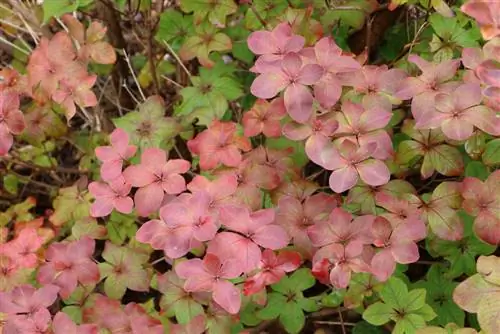
If all the flowers have opened after a few days, the houseplant should be placed on a bright, not full-sunny windowsill in a living room with temperatures between 18 and 20 degrees Celsius. A window facing south, southwest or southeast is ideal. The evergreen ornamental trees remain here until the end of the flowering period.
Tip:
Indoor azaleas prefer to spend the summer in a partially shaded location on the balcony. When the first buds appear in September, the flowering trees move back behind glass to a bright, cool location at 8 to 13 degrees Celsius so that the flower spectacle is repeated next winter.
Watering and fertilizing in winter
The exotic plants combine the flowering period with their native dry season, whereas the rainy season prevails in their tropical habitats during the European summer. Therefore, from September until the end of the flowering period, only water an indoor azalea when the substrate is noticeably dry. Please only use collected rainwater or decalcified tap water. Indoor azaleas in pots that are watered with hard water suffer from leaf chlorosis within a short period of time and drop their flowers in winter.
During the winter, an indoor azalea produces its flowers. Otherwise, the plant stops growing between September and April. Therefore, the nutrient supply is only limited to the period from May to August.
Tip:
Azaleas in pots rely on a special acidic substrate. Please only use azalea or ericaceous soil with a pH value of 4.0 to 5.5. Pure peat growing substrate does not satisfactorily meet the high quality requirements.
Pruning marks the end of overwintering
For your indoor azaleas, a shape and maintenance pruning marks the end of the winter care program. Withered flowers should be cleaned out promptly during overwintering so that the plant does not invest its energy in growing seeds. Before the care begins in the summer growing season, simply cut back shoots that are too long.
Recommended azaleas for the pot
Winter-hardy varieties
Gibr altar (Rhododendron luteum)
Do you have a soft spot for the color orange? Then you can't ignore this premium azalea. Its bright orange-red flowers have a delicate ruffle at the edge and reach a size of at least 8 cm. Before the lush green leaves fall to the ground in autumn, they take on a golden yellow and red color as a farewell. Since Gibr altar is one of the larger azaleas, this hybrid can easily overwinter outdoors in a pot, as these instructions explain.
- Flowering time: end of May to mid-June
- Growth height: 150 to 200 cm
Snow gold (Rhododendron luteum)
White flowers are a must on the summer balcony. The deciduous azalea keeps what its variety name promises. At the same time, the flowering shrub impresses with its dense, compact growth and a winter hardiness of up to -24 degrees Celsius. In the large pot, winter protection according to these instructions ensures that Schneegold will continue to develop its pure white flowers next year.
- Flowering period: May to June
- Growth height: 110 to 150 cm
Rococo (Rhododendron obtusum)
This Japanese azalea impresses with its cushion-shaped growth, which looks wonderful in the pot. Every single one of its salmon pink double flowers is a feast for the eyes. The slightly wavy flower edges create a particularly picturesque appearance. Although the gem is hardy when planted out to -24 degrees Celsius, it can be moved to a frost-free winter quarters in a small pot for the winter, as these instructions recommend.
- Flowering period: May to June
- Growth height: 30 to 40 cm
Evergreen indoor azaleas
Bicolor (Rhododendron simsii)
With white flowers and a red border, the flower-rich indoor azalea drives away winter dreariness. To ensure that the flowers are preserved for a long time, the temperatures at the location should not exceed 18 degrees.
- Flowering time: October to February
- Growth height: 25 to 40 cm
Magique (Rhododendron simsii)
The top-class indoor azalea boasts two-tone, flamed and double flowers. Depending on the viewer's perspective, the colors change in wonderful red tones. With so much floral splendor, the lack of winter hardiness of these evergreen ornamental trees can be overcome.
- Flowering time: October/November to March/April
- Growth height: 30 to 40 cm
Tip:
The flowers of potted azaleas last longer in a cozy living room if they spend the night in a cool location at 15 to 18 degrees Celsius.
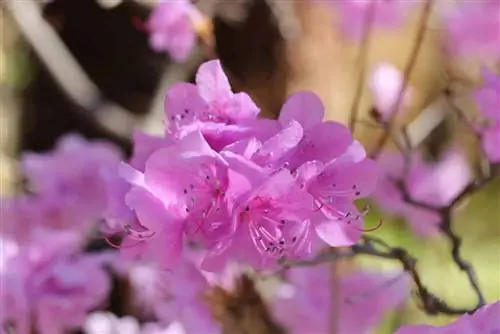
Rosalea (Rhododendron simsii)
Their lush, double, white flowers awaken the anticipation of next spring in the middle of winter. Rosalea is one of the classic indoor azaleas that reward the increased care required during wintering with an exuberant abundance of flowers.
- Flowering period: September to February/March
- Growth height: 25 to 50 cm
Conclusion
An azalea in a pot is either deciduous and hardy or evergreen and sensitive to frost. If you know this rule of thumb, it is not difficult to decide on the right winter storage arrangements. A winter-hardy garden azalea can stay outside in a pot with a diameter of more than 30 cm in a shady location protected from rain and wind. A foil coating and a wooden base keep severe frost away from the root ball. A small pot with its azalea moves to a frost-free winter quarters. The indoor azalea, on the other hand, would like a little more attention during the winter as it blooms at this time. After reading this guide to proper wintering, you will be familiar with all the steps you need to take to maneuver your potted azaleas through the cold season unscathed.

